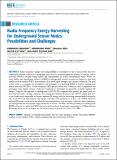| dc.contributor.author | Mahenge, Emmanuel | |
| dc.contributor.author | Sinde, Ramadhani | |
| dc.contributor.author | Dida, Mussa | |
| dc.contributor.author | Sam, Nael | |
| dc.date.accessioned | 2024-04-24T06:54:14Z | |
| dc.date.available | 2024-04-24T06:54:14Z | |
| dc.date.issued | 2024-03-28 | |
| dc.identifier.uri | https://dspace.nm-aist.ac.tz/handle/20.500.12479/2518 | |
| dc.description | This Journal was published by IEE Access 2024 | en_US |
| dc.description.abstract | Radio frequency energy harvesting (RFEH) is considered as one of the possible and envi-
ronmentally friendly solution for energizing sensor devices and prolonging the lifetime of wireless sensor
networks (WSNs). Despite being studied and experimented in several environments where WSNs are
used, studies and experiments related to RFEH in underground wireless systems are limited to near-field
wireless power transfer (WPT), measurement of received signal strength, and current conduction. The goal
of this study is to examine the possibilities and challenges of actualizing RFEH in wireless underground
sensor networks (WUSNs). A radio-frequency (RF) spectral survey was conducted, and a comparison was
performed with similar surveys conducted worldwide to determine the generally available ambient RF
energy. Using the aboveground to underground (AG2UG) RF communication model, the signal path loss
was analyzed under varying conditions. By relating the ambient RF power and AG2UG signal path loss,
it was found nearly impossible to harvest ambient RF energy with the harvesting antenna buried within the
soil, as the best-case environment will require a rectenna with sensitivity of at least −62.75dBm. However
ambient RF energy can be harvested when the harvesting antenna is in free space, while the other components
are underground and will require a high sensitivity of at least −40 dBm. Another possibility for underground
RFEH is the use of a dedicated WPT device located 1m above the ground, transmitting at 20 dBm with the
RF energy harvester 30 cm below the soil surface with a sensitivity of at least -28.5 dBm. | en_US |
| dc.description.sponsorship | This work was supported by the Higher Education for Economic Transformation (HEET) Project funded by the Government
of the United Republic of Tanzania via the Ministry of Education, Science and Technology, and the Mbeya University of
Science and Technology. | en_US |
| dc.description.uri | https://doi.org/10.1109/ACCESS.2024.3380372 | |
| dc.language.iso | en | en_US |
| dc.publisher | IEE ACCESS | en_US |
| dc.subject | Internet of Underground Things (IoUT) | en_US |
| dc.subject | Radio frequency energy harvesting (RFEH) | en_US |
| dc.subject | Wireless power transfer (WPT) | en_US |
| dc.subject | Wireless underground sensor networks (WUSNs) | en_US |
| dc.title | Radio Frequency Energy Harvesting for Underground Sensor Nodes: Possibilities and Challenges | en_US |
| dc.type | Article | en_US |

